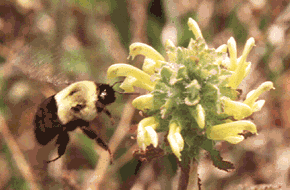Bumblebee Decisions: signal detection theory and decision-making
Pollinators and flowers are sometimes portrayed as "happy friends" -- the flowers give pollinators nectar and pollen, and pollinators fertilize the flowers. But nothing in nature is as simple as that! Many flowers do not offer nectar... but they may resemble other flowers that do.
Visiting nectarless flowers is a waste of time and energy for a bumblebee; but in trying to reject the nectarless flowers, the bee may miss some flowers that do have nectar.
What's a bumblebee to do?

In this module you will learn how signal detection theory can be used to explain decision-making in animals, using bumblebees as examples. Later in the module you'll discover how actual bumblebee research is advancing our knowledge of animal cognition.
Next: table of contents
Eager to jump right in? Skip the intro stuff
and go directly to the main story.
